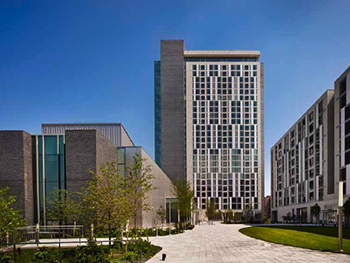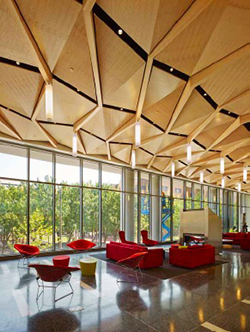Temple University Completes Construction
 PHILADELPHIA — Construction on Philadelphia’s Temple University’s new Mitchell and Hilarie Morgan Hall was recently completed after five years of project planning and construction.
PHILADELPHIA — Construction on Philadelphia’s Temple University’s new Mitchell and Hilarie Morgan Hall was recently completed after five years of project planning and construction.
The original master plan, known as the Temple 20/20 Masterplan was drafted in 2008 and detailed a pedestrian-friendly housing facility that would help bolster the relationship between the community and students. The new complex answers the plan and is located on the south side of campus on North Broad Street and Cecil B. Moore Avenue and serves as an effective pedestrian gateway to the main campus on the university’s north side.
Construction on the project began in August 2011 and recently reached completion this month. The buildings encompass a full city block and contain a total of 1,275 beds for Temple students. One building is a 27-story residential high-rise with 280,000 square feet. The second building is a mid-rise tower with 10 stories and 260,000 square feet. The third building in the complex is the dining and retail pavilion, with three stories that cover over 53,000 square feet. Additional elements of the project include a 45,000-square-foot terrace and a 40,000-square-foot garage.
The original goal of the project was to create new housing and dining spaces for the university. The surrounding community in north Philadelphia expressed a desire for more students to live back on campus, which helped to spur the planning for the project. While community members wanted students back on campus, they didn’t’ want the university to consume more city space by constructing additional facilities on more land. Because of this, the project team decided to build upwards, resulting in the new high-rise residential towers on campus.
The project team included an experienced group of contractors and design members. Temple signed contracts with the locally based architectural firm MGA Partners and LF Driscoll Co. LLC, while Aegis Property Group was the project manager. The project cost a total of $216 million. The university raised funds for the construction project from a multiple-year income plan devised for room, board and retail rental costs for students.
 The project team did face several challenges as construction on the project was underway. One of the main challenges was meeting the need to open the facility for the 2013 academic year while also staying under the budget. The limited area of the site called for significant coordination of logistics as well in order to help the project progress as smoothly as possible. Despite these setbacks, the project was a great success. The team attributes the positive outcome to the strong coordination between the university, MGA, Aegis and Driscoll.
The project team did face several challenges as construction on the project was underway. One of the main challenges was meeting the need to open the facility for the 2013 academic year while also staying under the budget. The limited area of the site called for significant coordination of logistics as well in order to help the project progress as smoothly as possible. Despite these setbacks, the project was a great success. The team attributes the positive outcome to the strong coordination between the university, MGA, Aegis and Driscoll.
The new housing and dining complex benefits the surrounding community as well as the students. The high-rise tower buildings stand as a bold statement as pedestrians approach the campus from Center City. It also serves as an effective gateway along Liacouras Walk, the main pedestrian walkway through campus. The food court facility, which includes 13 dining options, is open to the public. It promotes positive pedestrian activity as community members and students stream in and out of the terraced area.
The Morgan Hall construction project has helped liven up Broad Street as well. The adjacent street, which used to be largely unpopulated, is now more vibrant and lively as a result of the new pedestrian center nearby.
The Morgan Hall facilities are the first in a series of projects that will increase the student housing and dining options on campus for the Temple University population.
